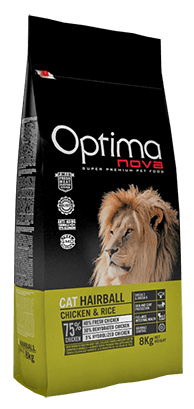Optima Nova
Hairball Chicken & Rice
Adult
Hairball
Indoor and Outdoor
Click to reveal the score breakdown
Tap to view ingredients, guaranteed analysis and more
Ingredients
Fresh chicken
40%
Dehydrated chicken meat
30%
Rice
10%
Corn
Chicken fat
Hydrolysed chicken liver
5%
Corn gluten
Beetroot pulp
Vegetable fibres
Yeast
and also:
Potato protein, Fish oil, Sodium chloride, Malt extract, Sodium polyphosphates, Inuline (source of fructooligosaccharides), (0.1%), Manano-oligosaccharides (0.1%), Potassium chloride.
Vitamins and Additives
Vitamin A 18000 ui/kg
Vitamin C 65 mg/kg
Vitamin D3 1500 ui/kg
Vitamin E 500 mg/kg
and also:
L-Taurine (975mg/kg), DL-methionine (500mg/kg), Iron (Ferrous sulphate monohydrate) (204mg/kg), Iodine (Potassium Iodide) (3.5mg/kg), Copper (Cupric Sulphate Pentahydrate) (10mg/kg), Manganese (Manganous Sulphate Monohydrate) (9mg/kg), Zinc (zinc oxide) (150mg/kg), Selenium (sodium selenite) (0.23mg/kg), Citric extracts rich in bioflavonoids (750mg/kg), Yucca extract (170mg/kg), Tocopherols
Guaranteed Analysis
Crude Protein
31.5%
Crude Fat
16%
Crude Fiber
4%
Moisture
9%
Crude Ash
7.1%
Calcium
1.2%
Phosphorus
0.9%
Omega 3
0.8%
Omega 6
3%
Product last updated: June 18, 2023, 7:28 AM
Please hold on while we’re getting the best offers for you
7405








